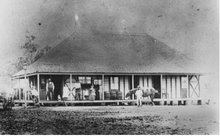Having gone through this unusually damp summer, I now know that a combination of previous saturating rain followed by a concentrated downpour leads to this kind of erosion. If the heavy clay soil is wet enough, any additional rain just runs off the surface and down the nearest gully, hopefully intercepted by someone’s dam. When you have these conditions you can stand and watch the hills turn white with the water running off every runnel and bump.
On Sunday, a very peculiar day, I had my first chance to check out the famous gully. It is amazing. Deep, heavily grassed and surrounded by trees, you could be in another world. You can just see houses on one crest but otherwise you are surrounded by the sound of grass and trees and cupped by the intense blue sky above. Blithe Boy and I rode down together on the trailer of concrete chunks. I felt like I was travelling back in time. Blithe Boy was silently entranced by the tractor. I suspect he’ll be another who will have to be convinced that a tractor isn’t necessary for two acres.
Apparently only a few weeks ago you could have whitewater rafted down the gully. We were blissfully unconscious of that rainfall – Christmas shopping in downtown Brisbane and coming home to a washed out driveway. Erosion continues apace and there are some impressive holes under the dense cover of grass. Our interests and that of a thoughtful neighbour coincided. We had a large amount of concrete to remove from Mr. Blithe’s two days of jackhammering the laundry slab and the neighbour needed the holes filled. Besides which, he had noticed our marked exhaustion and pitched in. We had planned a quiet day of recuperation and perhaps a little of the test match.
Instead, with the help of our neighbour and his shiny new tractor we shifted concrete. Added to this we had a potential builder visit, other neighbours hitching a ride in on the trailer for a quick visit, and the arrival of mother-in-law and friend whom I had completely forgotten were planning to visit. All this while covered in a particularly clinging mix of sweat, concrete dust and sunscreen.
 This same neighbour also helped us out by slashing a path in the front paddock for the truck to follow. We don’t want it to have any reason to wander off track whenever day the house arrives. I can only say that this is the right kind of neighbour to have – kind, tractor-owning and perhaps keen to get me back to blogging. Thanks Neighbour!
This same neighbour also helped us out by slashing a path in the front paddock for the truck to follow. We don’t want it to have any reason to wander off track whenever day the house arrives. I can only say that this is the right kind of neighbour to have – kind, tractor-owning and perhaps keen to get me back to blogging. Thanks Neighbour!










